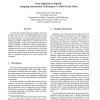Free Online Productivity Tools
i2Speak
i2Symbol
i2OCR
iTex2Img
iWeb2Print
iWeb2Shot
i2Type
iPdf2Split
iPdf2Merge
i2Bopomofo
i2Arabic
i2Style
i2Image
i2PDF
iLatex2Rtf
Sci2ools
TABLETOP
2008
IEEE
2008
IEEE
From DigiQuilt to DigiTile: Adapting educational technology to a multi-touch table
To realize the potential of multi-touch tables, interaction designers need to create meaningful applications for them in real-world contexts. One convenient shortcut towards that end is adapting a meaningful application from another interface paradigm. In this paper, we detail the process of adapting DigiQuilt, a single-user desktop educational technology, to DigiTile, a collaborative multi-touch application. With this case study, we concretely demonstrate the utility of adapting and how previous research and theory can inform that process. In particular, we show how learning theory (1) motivated the transition from the desktop to the multi-touch table, (2) guided the design process, and (3) informed the evaluation.
Collaborative Multi-touch Application | Human Computer Interaction | Meaningful Application | Multi-touch Table | TABLETOP 2008 |
| Added | 01 Jun 2010 |
| Updated | 01 Jun 2010 |
| Type | Conference |
| Year | 2008 |
| Where | TABLETOP |
| Authors | Jochen Rick, Yvonne Rogers |
Comments (0)

